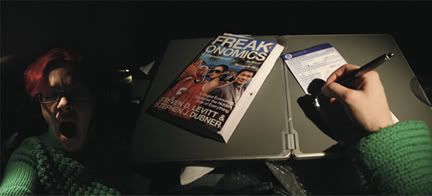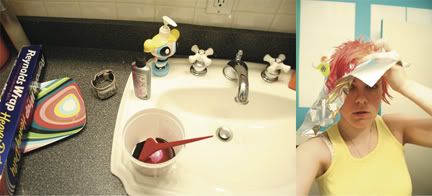Please see www.jasonbailerlosh.com or http://blog.art21.org/2010/04/30/inside-the-artists-studio-jason-bailer-losh/
Wednesday, May 9, 2007
Jason Bailer Losh
Please see www.jasonbailerlosh.com or http://blog.art21.org/2010/04/30/inside-the-artists-studio-jason-bailer-losh/
Saturday, April 14, 2007
Saturday, March 17, 2007
Sunday, March 11, 2007
11.
"When a tree grows, it's not to provide homes for birds. The bird is a parasite on the tree just as human beings are parasites on houses. The building which I have created is itself its own meaning. See how simple, how bold the lines! a cement pole sixty meters high supporting those double-walled rubber globes! (And indeed the effect was of a bunch of gigantic red currants painted in many colors.) No walls or roof or windows; it's a long time since we jettisoned such superstitions. Each globe is decorated inside in accordance with my specifications, and a central lift enables the visitor to inspect them without fatigue. The temperature is kept exactly at the ideal level for the ideal human organism as defined by our experts. It is the only temperature at which nobody feels comfortable: some shiver and others sweat. That's how science in this day and age serves art to make houses uninhabitable. This one should last at least six months."
René Daumal (1908-1944). A Night of Serious Drinking. Chapter 11
Saturday, March 10, 2007
Friday, March 9, 2007
"The last decade has seen an increasing use by young artists of strategies and forms derived from neo-avant-gardes—Fluxus, Conceptual or Performance art. This has called forth charges of plagiarism from an older generation of artists, who feel the young brats are getting credit for ‘things we did thirty years ago’, without acknowledging and sometimes—even worse—without knowing their predecessors’ work. Are these repetitions, then, the blind, dumb survivals of forms long past their prime? There are indeed young artists making neo-Conceptual or Fluxus-type work that seems an exasperatingly minuscule variation on what has been done before: creating ‘social works of art’ by cooking dinners or spending the night with strangers; taking ‘jobs’ in non-art professions. While many such strategies bear an uncanny resemblance to activities in the sixties that were far more marginal, and far less commercially successful, the fact remains that the repetition of a given practice within a changed historical and cultural context has a different meaning and function. Theory has not found it easy to come to grips with this phenomenon, in part because we still find it difficult to think about history in terms of survivals and repetitions—as what Hal Foster has called a ‘continual process of protension and retension, a complex relay of anticipated futures and reconstructed pasts’. The crucial question is whether (and how) artists actually manage to reactivate avant-garde impulses, or whether they merely recycle some of its forms in a nostalgic mode. In the first instance, they would resemble Benjamin’s Jacobins, seizing on the revolutionary potential of the Roman Republic to realize its now-time. In the second, they would be closer to the postmodern pastiche-artists that Jameson analysed in the eighties as, precisely, recycling disembodied signs. Whereas Benjamin perceived the liberating potential of breaking through linear history in order to arrive at a ‘dialectical image’, Jameson concluded that the postmodern era resulted in a consumption of nostalgic motifs completely devoid of true historical consciousness. The active, revolutionary repetition described by Benjamin had been perverted into a passive, consumerist reflex. The distinction between the two positions, however, is not necessarily clear-cut. There may be complex amalgams of both in any historical phenomenon—delusion and denial as the boon companions of insight. Aby Warburg was convinced that the practice of the Renaissance was just such a hybrid—artists deliberately sought to use antique forms, seeing a now-time in them; but they were also taken over by the forms, possessed. Their repetitions were not completely sovereign and intentional; at times they were involuntary, like neurotic symptoms. Nonetheless, Warburg was firmly on the side of reason, and focused on artists’ attempts to master the pagan impulses encoded in the antique Pathosformeln that they deployed. "
The Lost Dress of Paradise, A Theology of Nakedness: Vanessa Beecroft’s Performance in Berlin By Giorgio Agamben [Originally published in German in the Frankfurter Allgemeine Zeitung]
The first impression that the performance by Vanessa Beecroft gave the audience present at the Neue Nationalgalerie was of a political nature: nothing but dressed urban people, looking at naked urban people. The extreme and at the same time hopeless situation of man in mass society shows itself yet again in its full ambiguity, in this strange form that characterises the situation of contemporary man: as non-event. Something that could have happened did not take place.
If, however, someone in retrospect would reflect on the peculiarities of this non-event, the initial impression – that as could be expected was of a political nature – would be pushed aside by a genuine theological consideration. For exactly what was it that had not taken place? Neither an orgy, nor torture, nor an S&M session, but the simple nakedness of man.
In our culture, nakedness is inseparably tied up to a theological meaning. And this is not only because, when looking at these one hundred random women – standing in rows, dressed only in nylon-stockings, who were lingering without moving, as if they were expecting something – you could not avoid thinking about the nakedness of the resurrected at Judgement Day. These people, exposed as naked, I thought, are the resurrected waiting for judgement. The dressed people circling around them were, without knowing it, servants in some celestial administration, who were preparing to lead them to heaven or cast them into Gehenna.
Not only this – the theological significance of exposing someone as naked goes even deeper. We all know the narrative of Genesis, in which Adam and Eve noticed their nakedness only after the original sin. According to the theologians, this was not due only to an earlier state of simple ignorance: despite the fact that Adam and Eve were not covered in human clothing before the fall, they were still not naked. They were covered in a dress of mercy, of tight-fitting glory. Sin robbed man of this supernatural dress, and, in his nakedness, he is forced to cover himself – first with fig leaves, and then with animal skin. The dress with which he now covers his body is no longer the dress of mercy and innocence, but a dress of sin and hypocrisy. This dress belongs to him as a necessity, because it is at the same time a reminiscence of the lost dress of Paradise and a promise of the new dress that will be given to him through redemption.
There is a special Christian dignity of the dress that stretches itself even to the last trends in fashion: “The dress worn by fallen man”, a modern theologian writes, “represents a reminiscence of the lost dress that man once wore in Paradise. Every change and innovation in fashion that we are so willing to follow, which promises us a beginning of self-understanding, is nothing but the activation of the hope for the lost dress to be recovered (…) This dress, which we have had and lost and that we are still looking for in all the garments of the world that we are wearing, is given to us as a gift in the sacrament of baptism.”
These considerations allow us now to think in a new way about the nakedness that did not take place in Vanessa Beecroft’s performance. According to the founding axiom of the Christian theology of clothing, human nakedness is only possible, if at all, as something temporary and negative. Firstly, because in Eden the creaturely body was already clothed in divine mercy; secondly, because the body after the Fall is again covered in clothes that are the consequence of baptism; and finally, because the saved ones in Paradise will be dressed in a new dress of glory that can no longer be taken off. Nakedness exists, if at all, only in Hell. When it temporarily appears in life in the moment of sinning, nakedness remains unthought and uninterpreted, because its only meaning is related to the dress of mercy.
Now it is possible to understand why in Vanessa Beecroft’s performance – that took place not in Hell but at the Neue Nationalgalerie and had absolutely nothing sinful about it – there could be no event of nakedness. As an unrestrained accomplice to Christian theology – with which it was, without knowing it, filled to the brim – this performance exhibited nothing but the impossibility of nakedness.
The last word will therefore be a political consideration. Against this complicity of commodity and theology we must try to think a possible nakedness of man – something that theology, and then reification and pornography, have made unthinkable. What we must find again is the nakedness of Adam, before God covered him in a dress of glory. This, however, should neither be understood as a natural condition, nor as a promise of something to come. This nakedness is, rather, something that we, here and now, must liberate, piece by piece, from the theological fabric that is wrapped around it.
According to a Gnostic parable, the saved ones will, in the very last day, take the dress of light that was given to them by God on the last day, and tear it off their bodies. They will show themselves to each other in a nakedness that knows neither of sin nor of glory. The human body that will be seen that day will be like the body of that girl in the Neue Nationalgalerie that I, in passing, looked at from behind, only to immediately again lose sight of her: fragile, simple, nameless, yet without doubt naked, and unproblematically thinkable.
Tuesday, March 6, 2007
New Paintings


Wheeeeeeeeeeeeeeeeeeeeeeeeeeeee, now here’s the plot: you’ve got all these fucking people, good looks and weird clothes, singing songs together in a bar while their bodies move like one giant hand clap, saying yesssir with butts in the air and who cares? Because this is the end of something special that we’re now only realizing happened in the first place and that was our twenties and I guess for that person it was early thirties but goddamn we’re HOT and now I want to fuck everyone – why haven’t I already?
Saturday, March 3, 2007
Wednesday, February 28, 2007
Lara Star Martini : Project 24

project 24 is a year long study of my life. i spent the last year from my 24th birthday (february 11) to my 25th birthday (february 11). at 8 o’clock every night i took a photo of myself and what i was looking at. i took a typical portrait and typical landscape shot, and even kept the constraints the same for each type of image.

the main focus of all of my work has been honesty- and have made a conscious decision to leave behind the air brushed glamour and fantasy i used to strive for- which i still respect and love- in favor of the raw, honest truth. you get to see me ‘cleaned up’, but more often than not, you see a hot mess. this is the truth. and that is why i want to share it.

why do this? or the most common question i receive: why should you care about me? i believe art about people should be an accurate and detailed story. the deeper and more honest you get, the more personal the work becomes. the more personal the work becomes, the closer you are to the subject. the closer you are to the subject, the more you can relate. the more you can relate, the more you can understand and appreciate. the art becomes as much of a mirror as it does a portrait.

i tried to answer the following question: can a thin slice of everyday life accurately present who you are? how much information is needed to tell your story, to let people see you for who you are? why this is important to me is a question i don’t bother answering, all i know is the need in my heart to answer it.
Tuesday, February 27, 2007
Ann Oren

I would like to investigate different modes of communication with the drama infused viewer, trying to dig into their inner will to exhibit their banality. This viewer is one in the age of reality TV and YouTube (which legitimize this type of exhibitionism), hence in the age of the idealization of a man without qualities. I would like to propose an ambivalent power dynamic between the piece and the viewer based on themes of the self exposed to “the other” and “the other” exposed to the self. I would like to reach out to the viewer by presenting the work with recorded personas performing simple, everyday activities. Then I will attempt to install/juxtapose the video in a certain form in space to bring another psychological level for the viewer to encounter. I would like for the three: video-space-viewer to have equal parts in what the piece actually ends up becoming. I hope that my work’s possibilities will shift from one viewer to the next based on incorporating their personal perception.
personal site:
www.AnnOren.com

Friday, February 16, 2007
Crisman


I'm dealing with desire through fantasy and role playing. The idea of the human as a hot-house flower really interests me. A protected, pasty, and flabby body bound in starched cotton and velvet. How do the pampered spend their time? I present different scenarios, through video, drawing and installation, of how a peculiar character spends their time. These objects are dealing with the deflection of sexuality through ritual. Who has the time to invest careful attention into making something that has a seemingly impractical function?
Thursday, February 15, 2007
yejin yoo

I am attracted to the irony of the limitation of square canvas and the boundless universe it can contain. When I detect contradiction in my painting, that’s when creative force takes place-- traces of how I relate and respond to this contradiction become the layers of dialogue in my paintings. I bounce back and forth between the chaos and the intuitive order I create. This labyrinth is the domain of my paintings.
Like life, I build vocabulary through experience in every painting I make, and I utilize the vocabulary I gain not to define what I’ve already seen but to expand yet another realm of vocabulary. To do so, I am naturally against formulas that create concrete system. I put anticipation and get the variations of my anticipation. The space left for these variations is where I find breath of life in my paintings.
Sunday, February 11, 2007
Mike Egan
I wear my heart on my sleeve.
Criticism is an act of love.
I pursue no objectives, no system, no tendency; I have no programme, no style, no direction. I have no time for specialized concerns, working themes, or variations that lead to mastery.
I steer clear of definitions, I don't know what I want. I am inconsistent, non-committal, passive; I like the indefinite, the boundless; I like continual uncertainty. Other qualities may be conducive to achievement, publicity, success; but they are all outworn - as outworn as ideologies, opinions, concepts, and names for things.
Now that there are no priests or philosophers left, artists are the most important people in the world. That is the only thing that interests me.
Gerhard Richter, Notes, 1966
Saturday, February 10, 2007
R. Sullivan

My work deals with issues of marginality, structure analysis, multiple meaning, humor, and cohesive diversion. I am attracted to the cast off and overlooked, the lost, and the spaces in-between things. It is my practice to view things metathetically, as pieces, or potentialites rather than wholes. A state of potential is the most potent to be in. When visual constants representing everyday reality such as perspective or light direction are viewed as instances of meaning rather than absolutes, reality itself becomes a tool instead of a state. This allows traditional standards to transgress into absurdities. I manipulate the make-up of visual signifiers, often referencing (art) history, to generate a terminal in which the viewer freely draws lines of meaning. By staging events in Synesthetic environments and mixed cultural sites the work permits a state in which people, Places, and the elements are transitory.
Here's a link to my thesis blog
flickr.com/photos/rsullivan
woodcliffe@gmail.com
lai chung poon

I admire painful and laborious process, the more the better. Traditionally drawn animation is a painful process. I am proud when I create an animated "thing". The drawings become alive in a different world that I can't touch, but can observe. I believe that the body only exists in tension and making animations revolving around that idea, makes me feel like a little god.
brianelectro

wayne atkins, "short circuit" at taxter & spengemann
hmmm?
zzzzzzzzzzzzzzzzzzzzzzzzzzzzzzzzzzzzzzzzzzzzzzzzzzzzzzzzzzzzzzzzzzzzzzzzz
zzzzzzzzzzzzzzzzzzzzzzzzzzzzzzzzzzz
zzzzzzzzzzzzzzzzzzzzzzz
zzzzzzzzzzzzzzzz
get out of my miiiinnndddd
aaaaaaaaaahhhhhhhhhhhhh!!!!!
uhhhhhh]
aaaahhh
++++++++++++++
++++++
++
+

guns bitches!!

link it up:
www.flickr.com/photos/brianelectro
www.myspace.com/brianelectro
buy dash snow's coke here
read the review here
DASH SNOW”S COKE
Hi my name is brianelectro. My boys and I broke into dash snow’s apartment and stole all his coke. Don’t miss this once in a lifetime opportunity to own dash snow’s coke. And it’s a lot of fucking coke!!

think of the fun, think of the glamour!! With dash snow’s coke you can be a pretentious rich poseur who masquerades as a poor, wild hipster artist!! Be the envy of all your friends
this is digital art













